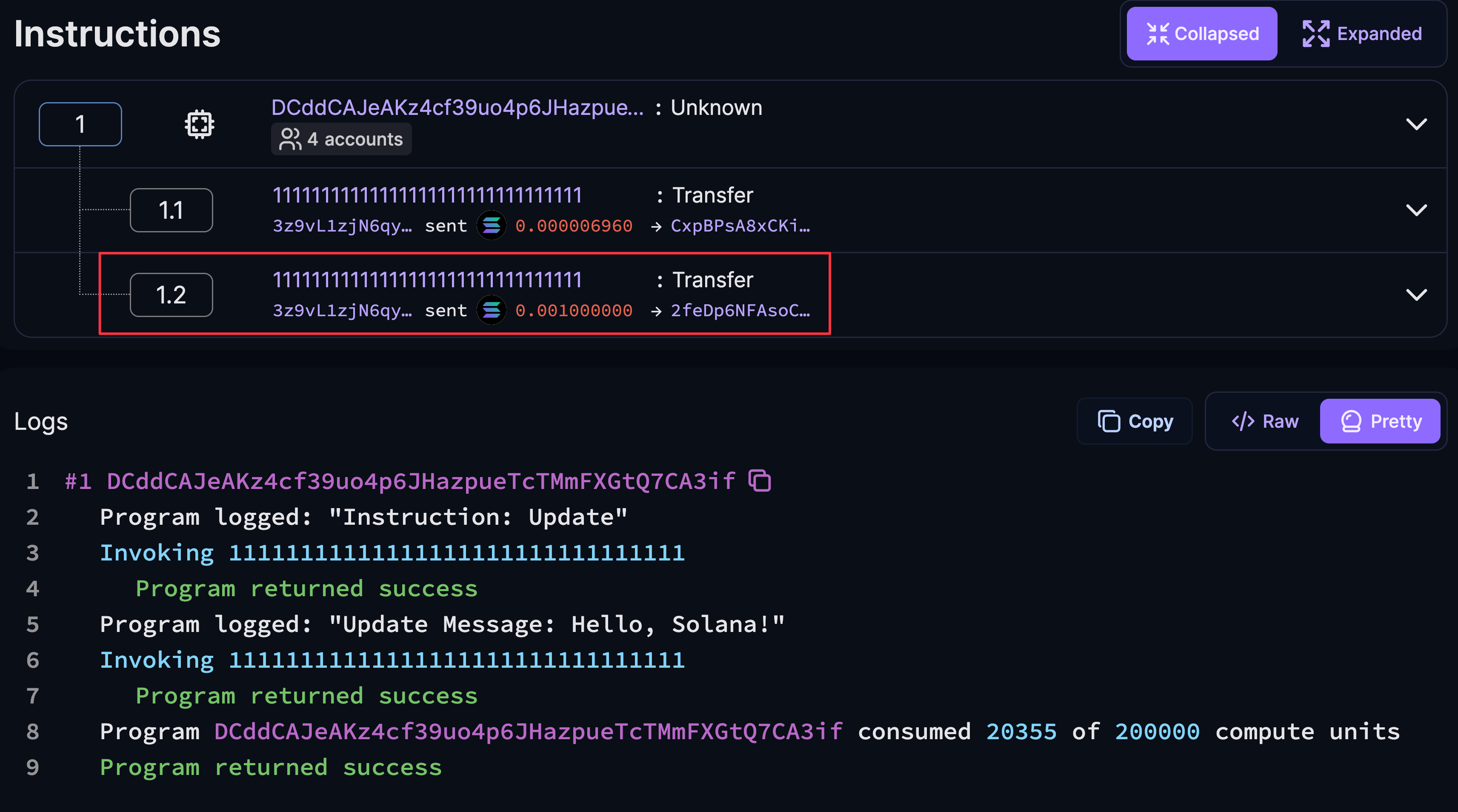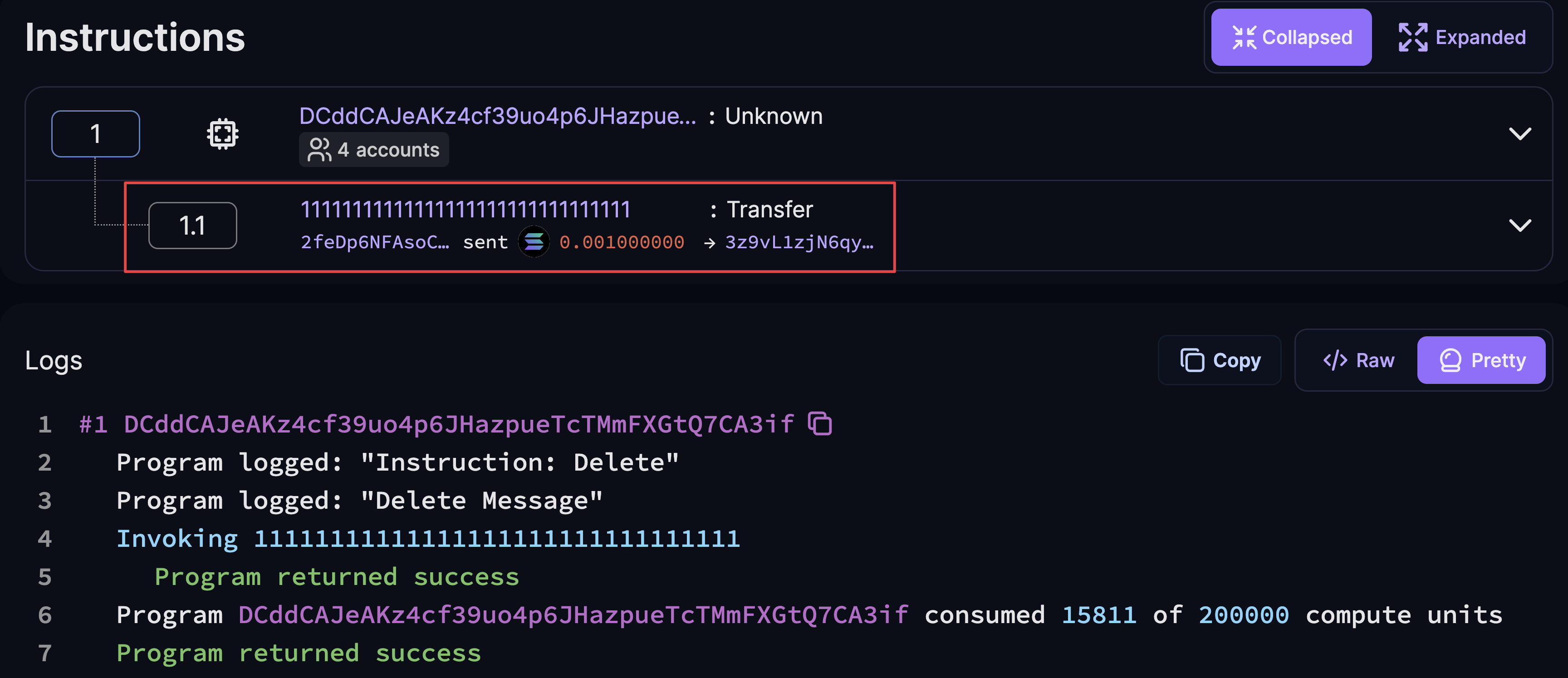Cross Program Invocation
In this section, we'll update the CRUD program from the previous PDA section to
include Cross Program Invocations (CPIs). We'll modify the program to transfer
SOL between accounts in the update and delete instructions, demonstrating
how to interact with other programs (in this case, the System Program) from
within our program.
The purpose of this section is to walk through the process of implementing CPIs in a Solana program using the Anchor framework, building upon the PDA concepts we explored in the previous section. For more details, refer to the Cross Program Invocation page.
Modify Update Instruction
First, we'll implement a simple "pay-to-update" mechanism by modifying the
Update struct and update function.
Begin by updating the lib.rs file to bring into scope items from the
system_program module.
use anchor_lang::system_program::{transfer, Transfer};
use anchor_lang::prelude::*;
+ use anchor_lang::system_program::{transfer, Transfer};
Next, update the Update struct to include an additional account called
vault_account. This account, controlled by our program, will receive SOL from
a user when they update their message account.
#[account(
mut,
seeds = [b"vault", user.key().as_ref()],
bump,
)]
pub vault_account: SystemAccount<'info>,
#[derive(Accounts)]
#[instruction(message: String)]
pub struct Update<'info> {
#[account(mut)]
pub user: Signer<'info>,
+ #[account(
+ mut,
+ seeds = [b"vault", user.key().as_ref()],
+ bump,
+ )]
+ pub vault_account: SystemAccount<'info>,
#[account(
mut,
seeds = [b"message", user.key().as_ref()],
bump = message_account.bump,
realloc = 8 + 32 + 4 + message.len() + 1,
realloc::payer = user,
realloc::zero = true,
)]
pub message_account: Account<'info, MessageAccount>,
pub system_program: Program<'info, System>,
}
We're adding a new account called vault_account to our Update struct. This
account serves as a program-controlled "vault" that will receive SOL from users
when they update their messages.
By using a PDA for the vault, we create a program-controlled account unique to each user, enabling us to manage user funds within our program's logic.
Key aspects of the vault_account:
- The address of the account is a PDA derived using seeds
[b"vault", user.key().as_ref()] - As a PDA, it has no private key, so only our program can "sign" for the address when performing CPIs
- As a
SystemAccounttype, it's owned by the System Program like regular wallet accounts
This setup allows our program to:
- Generate unique, deterministic addresses for each user's "vault"
- Control funds without needing a private key to sign for transactions.
In the delete instruction, we'll demonstrate how our program can "sign" for
this PDA in a CPI.
Next, implement the CPI logic in the update instruction to transfer 0.001 SOL
from the user's account to the vault account.
let transfer_accounts = Transfer {
from: ctx.accounts.user.to_account_info(),
to: ctx.accounts.vault_account.to_account_info(),
};
let cpi_context = CpiContext::new(
ctx.accounts.system_program.to_account_info(),
transfer_accounts,
);
transfer(cpi_context, 1_000_000)?;
pub fn update(ctx: Context<Update>, message: String) -> Result<()> {
msg!("Update Message: {}", message);
let account_data = &mut ctx.accounts.message_account;
account_data.message = message;
+ let transfer_accounts = Transfer {
+ from: ctx.accounts.user.to_account_info(),
+ to: ctx.accounts.vault_account.to_account_info(),
+ };
+ let cpi_context = CpiContext::new(
+ ctx.accounts.system_program.to_account_info(),
+ transfer_accounts,
+ );
+ transfer(cpi_context, 1_000_000)?;
Ok(())
}
In the update instruction, we implement a Cross Program Invocation (CPI) to
invoke the System Program's transfer instruction. This demonstrates how to
perform a CPI from within our program, enabling the composability of Solana
programs.
The Transfer struct specifies the required accounts for the System Program's
transfer instruction:
-
from- The user's account (source of funds) -
to- The vault account (destination of funds)let transfer_accounts = Transfer {
from: ctx.accounts.user.to_account_info(),
to: ctx.accounts.vault_account.to_account_info(),
};
The CpiContext specifies:
-
The program to be invoked (System Program)
-
The accounts required in the CPI (defined in the
Transferstruct)let cpi_context = CpiContext::new(
ctx.accounts.system_program.to_account_info(),
transfer_accounts,
);
The transfer function then invokes the transfer instruction on the System
Program, passing in the:
-
The
cpi_context(program and accounts) -
The
amountto transfer (1,000,000 lamports, equivalent to 0.001 SOL)transfer(cpi_context, 1_000_000)?;
The setup for a CPI matches how client-side instructions are built, where we
specify the program, accounts, and instruction data for a particular instruction
to invoke. When our program's update instruction is invoked, it internally
invokes the System Program's transfer instruction.
Rebuild the program.
build
Modify Delete Instruction
We'll now implement a "refund on delete" mechanism by modifying the Delete
struct and delete function.
First, update the Delete struct to include the vault_account. This allows us
to transfer any SOL in the vault back to the user when they close their message
account.
#[account(
mut,
seeds = [b"vault", user.key().as_ref()],
bump,
)]
pub vault_account: SystemAccount<'info>,
Also add the system_program as the CPI for the transfer requires invoking the
System Program.
pub system_program: Program<'info, System>,
#[derive(Accounts)]
pub struct Delete<'info> {
#[account(mut)]
pub user: Signer<'info>,
+ #[account(
+ mut,
+ seeds = [b"vault", user.key().as_ref()],
+ bump,
+ )]
+ pub vault_account: SystemAccount<'info>,
#[account(
mut,
seeds = [b"message", user.key().as_ref()],
bump = message_account.bump,
close= user,
)]
pub message_account: Account<'info, MessageAccount>,
+ pub system_program: Program<'info, System>,
}
The vault_account uses the same PDA derivation as in the Update struct.
Add the vault_account to the Delete struct enables our program to access the
user's vault account during the delete instruction to transfer any accumulated
SOL back to the user.
Next, implement the CPI logic in the delete instruction to transfer SOL from
the vault account back to the user's account.
let user_key = ctx.accounts.user.key();
let signer_seeds: &[&[&[u8]]] =
&[&[b"vault", user_key.as_ref(), &[ctx.bumps.vault_account]]];
let transfer_accounts = Transfer {
from: ctx.accounts.vault_account.to_account_info(),
to: ctx.accounts.user.to_account_info(),
};
let cpi_context = CpiContext::new(
ctx.accounts.system_program.to_account_info(),
transfer_accounts,
).with_signer(signer_seeds);
transfer(cpi_context, ctx.accounts.vault_account.lamports())?;
Note that we updated _ctx: Context<Delete> to ctx: Context<Delete> as we'll
be using the context in the body of the function.
- pub fn delete(_ctx: Context<Delete>) -> Result<()> {
+ pub fn delete(ctx: Context<Delete>) -> Result<()> {
msg!("Delete Message");
+ let user_key = ctx.accounts.user.key();
+ let signer_seeds: &[&[&[u8]]] =
+ &[&[b"vault", user_key.as_ref(), &[ctx.bumps.vault_account]]];
+
+ let transfer_accounts = Transfer {
+ from: ctx.accounts.vault_account.to_account_info(),
+ to: ctx.accounts.user.to_account_info(),
+ };
+ let cpi_context = CpiContext::new(
+ ctx.accounts.system_program.to_account_info(),
+ transfer_accounts,
+ ).with_signer(signer_seeds);
+ transfer(cpi_context, ctx.accounts.vault_account.lamports())?;
Ok(())
}
In the delete instruction, we implement another Cross Program Invocation (CPI) to invoke the System Program's transfer instruction. This CPI demonstrates how to make a transfer that requires a Program Derived Address (PDA) signer.
First, we define the signer seeds for the vault PDA:
let user_key = ctx.accounts.user.key();
let signer_seeds: &[&[&[u8]]] =
&[&[b"vault", user_key.as_ref(), &[ctx.bumps.vault_account]]];
The Transfer struct specifies the required accounts for the System Program's
transfer instruction:
-
from: The vault account (source of funds)
-
to: The user's account (destination of funds)
let transfer_accounts = Transfer {
from: ctx.accounts.vault_account.to_account_info(),
to: ctx.accounts.user.to_account_info(),
};
The CpiContext specifies:
-
The program to be invoked (System Program)
-
The accounts involved in the transfer (defined in the Transfer struct)
-
The signer seeds for the PDA
let cpi_context = CpiContext::new(
ctx.accounts.system_program.to_account_info(),
transfer_accounts,
).with_signer(signer_seeds);
The transfer function then invokes the transfer instruction on the System Program, passing:
-
The
cpi_context(program, accounts, and PDA signer) -
The amount to transfer (the entire balance of the vault account)
transfer(cpi_context, ctx.accounts.vault_account.lamports())?;
This CPI implementation demonstrates how programs can utilize PDAs to manage funds. When our program's delete instruction is invoked, it internally calls the System Program's transfer instruction, signing for the PDA to authorize the transfer of all funds from the vault back to the user.
Rebuild the program.
build
Redeploy Program
After making these changes, we need to redeploy our updated program. This ensures that our modified program is available for testing. On Solana, updating a program simply requires deploying the compiled program at the same program ID.
deploy
$ deploy
Deploying... This could take a while depending on the program size and network conditions.
Deployment successful. Completed in 17s.
Only the upgrade authority of the program can update it. The upgrade authority is set when the program is deployed, and it's the only account with permission to modify or close the program. If the upgrade authority is revoked, then the program becomes immutable and can never be closed or upgraded.
When deploying programs on Solana Playground, your Playground wallet is the upgrade authority for all your programs.
Update Test File
Next, we'll update our anchor.test.ts file to include the new vault account in
our instructions. This requires deriving the vault PDA and including it in our
update and delete instruction calls.
Derive Vault PDA
First, add the vault PDA derivation:
const [vaultPda, vaultBump] = PublicKey.findProgramAddressSync(
[Buffer.from("vault"), wallet.publicKey.toBuffer()],
program.programId,
);
describe("pda", () => {
const program = pg.program;
const wallet = pg.wallet;
const [messagePda, messageBump] = PublicKey.findProgramAddressSync(
[Buffer.from("message"), wallet.publicKey.toBuffer()],
program.programId
);
+ const [vaultPda, vaultBump] = PublicKey.findProgramAddressSync(
+ [Buffer.from("vault"), wallet.publicKey.toBuffer()],
+ program.programId
+ );
// ...tests
});
Modify Update Test
Then, update the update instruction to include the vaultAccount.
const transactionSignature = await program.methods
.update(message)
.accounts({
messageAccount: messagePda,
vaultAccount: vaultPda,
})
.rpc({ commitment: "confirmed" });
const transactionSignature = await program.methods
.update(message)
.accounts({
messageAccount: messagePda,
+ vaultAccount: vaultPda,
})
.rpc({ commitment: "confirmed" });
Modify Delete Test
Then, update the delete instruction to include the vaultAccount.
const transactionSignature = await program.methods
.delete()
.accounts({
messageAccount: messagePda,
vaultAccount: vaultPda,
})
.rpc({ commitment: "confirmed" });
const transactionSignature = await program.methods
.delete()
.accounts({
messageAccount: messagePda,
+ vaultAccount: vaultPda,
})
.rpc({ commitment: "confirmed" });
Rerun Test
After making these changes, run the tests to ensure everything is working as expected:
test
$ test
Running tests...
anchor.test.ts:
pda
{
"user": "3z9vL1zjN6qyAFHhHQdWYRTFAcy69pJydkZmSFBKHg1R",
"message": "Hello, World!",
"bump": 254
}
Transaction Signature: https://solana.fm/tx/qGsYb87mUUjeyh7Ha7r9VXkACw32HxVBujo2NUxqHiUc8qxRMFB7kdH2D4JyYtPBx171ddS91VyVrFXypgYaKUr?cluster=devnet-solana
✔ Create Message Account (842ms)
{
"user": "3z9vL1zjN6qyAFHhHQdWYRTFAcy69pJydkZmSFBKHg1R",
"message": "Hello, Solana!",
"bump": 254
}
Transaction Signature: https://solana.fm/tx/3KCDnNSfDDfmSy8kpiSrJsGGkzgxx2mt18KejuV2vmJjeyenkSoEfs2ghUQ6cMoYYgd9Qax9CbnYRcvF2zzumNt8?cluster=devnet-solana
✔ Update Message Account (946ms)
Expect Null: null
Transaction Signature: https://solana.fm/tx/3M7Z7Mea3TtQc6m9z386B9QuEgvLKxD999mt2RyVtJ26FgaAzV1QA5mxox3eXie3bpBkNpDQ4mEANr3trVHCWMC2?cluster=devnet-solana
✔ Delete Message Account (859ms)
3 passing (3s)
You can then inspect the SolanFM links to view the transaction details, where you’ll find the CPIs for the transfer instructions within the update and delete instructions.


If you encounter any errors, you can reference the final code.
Next Steps
You've completed the Solana Quickstart guide! You've learned about accounts, transactions, PDAs, CPIs, and deployed your own programs.
Visit the Core Concepts pages for more comprehensive explanations of the topics covered in this guide.
Additional learning resources can be found on the Developer Resources page.
Explore More Examples
If you prefer learning by example, check out the Program Examples Repository for a variety of example programs.
Solana Playground offers a convenient feature allowing you to import or view projects using their GitHub links. For example, open this Solana Playground link to view the Anchor project from this Github repo.
Click the Import button and enter a project name to add it to your list of
projects in Solana Playground. Once a project is imported, all changes are
automatically saved and persisted within the Playground environment.